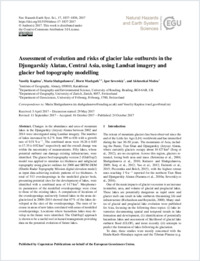Assessment of evolution and risks of glacier lake outbursts in the Djungarskiy Alatau, Central Asia, using Landsat imagery and glacier bed topography modelling
- Kapitsa, Vassiliy Institute of Geography, Almaty, Kazakhstan
- Shahgedanova, Maria Department of Geography and Environmental Science, University of Reading, UK
- Machguth, Horst Department of Geography, University of Zurich, Switzerland - Department of Geosciences, University of Fribourg, Switzerland
- Severskiy, Igor Institute of Geography, Almaty, Kazakhstan
- Medeu, Akhmetkal Institute of Geography, Almaty, Kazakhstan
-
24.10.2017
Published in:
- Nat. Hazards Earth Syst. Sci.. - 2017, vol. 17, no. 10, p. 1837–1856
English
Changes in the abundance and area of mountain lakes in the Djungarskiy (Jetysu) Alatau between 2002 and 2014 were investigated using Landsat imagery. The number of lakes increased by 6.2 % from 599 to 636 with a growth rate of 0.51 % a−1. The combined areas were 16.26 ± 0.85 to 17.35 ± 0.92 km2 respectively and the overall change was within the uncertainty of measurements. Fifty lakes, whose potential outburst can damage existing infrastructure, were identified. The glacier bed topography version 2 (GlabTop2) model was applied to simulate ice thickness and subglacial topography using glacier outlines for 2000 and SRTM DEM (Shuttle Radar Topography Mission digital elevation model) as input data achieving realistic patterns of ice thickness. A total of 513 overdeepenings in the modelled glacier beds, presenting potential sites for the development of lakes, were identified with a combined area of 14.7 km2. Morphometric parameters of the modelled overdeepenings were close to those of the existing lakes. A comparison of locations of the overdeepenings and newly formed lakes in the areas de-glacierized in 2000– 2014 showed that 67 % of the lakes developed at the sites of the overdeepenings. The rates of increase in areas of new lakes correlated with areas of modelled overdeepenings. Locations where hazardous lakes may develop in the future were identified. The GlabTop2 approach is shown to be a useful tool in hazard management providing data on the potential evolution of future lakes.
- Faculty
- Faculté des sciences et de médecine
- Department
- Département de Géosciences
- Language
-
- English
- Classification
- Hydrology
- License
-
License undefined
- Identifiers
-
- RERO DOC 306234
- DOI 10.5194/nhess-17-1837-2017
- Persistent URL
- https://folia.unifr.ch/unifr/documents/306174
Statistics
Document views: 134
File downloads:
- pdf: 161
